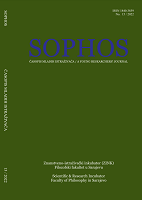UGO FOSCOLO IZMEĐU NEOKLASICIZMA I PREDROMANTIZMA
UGO FOSCOLO BETWEEN NEOCLASSICISM AND PREROMANTISM
Author(s): Mirza MejdanijaSubject(s): 18th Century, 19th Century, Theory of Literature, Italian literature
Published by: Filozofski fakultet u Sarajevu - Znanstveno-istraživački inkubator
Keywords: neoclassicism; preromanticism; revolution; dismay; escape;
Summary/Abstract: By the end of the 18th century, Italy was under Napoleon’s dominance. It was the time when centuries-long European values were being changed due to the Industrial, but also French revolution. The outcome of these enormous changes was an emergence of two artistic movements – neoclassicism and preromanticism that co-existed in Italy at the time. The most renowned Italian author of the 19th century, Ugo Foscolo, is a representative of both of these movements in the Italian literature. Neoclassicism and preromanticism emerged in the attempt to find an alternative to the same issues and, therefore, they co-existed in the same period of time, the elements of which are often present in the same authors, or even in one work of art. Foscolo is the author of Grazie, a neoclassical masterpiece of Italian literature, but also of the most significant work of the Italian preromanticism, the novel titled The Last Letters of Jacopo Ortis. Both of these works present an attempt to escape the disappointing circumstances of the period in question. What is relevant is not the different directions at which these attempts of escapism were pointed, but the very need to do so. Culturally, in both cases, the rejection of the reality is evident. Both tendencies may be observed as a quest for an alternative to the existing conditions that are depressing: for neoclassicism, the alternative is found in the ideal of beauty and harmony, distant from the historical horrors and defeats. For preromanticism, it is the depths of one’s own self, in the union with nature, pastorally viewed as the centre of life’s authenticity. The different directions of escapism are no longer of any importance, but the very need to escape, which is what these two movements have in common. What we are about to explore in the present paper are the characteristics of neoclassicism and preromanticism in Italian literature, primarily in the works of Ugo Foscolo, the most influential Italian author of that period.
Journal: Sophos- časopis mladih istraživača
- Issue Year: 2022
- Issue No: 15
- Page Range: 89-101
- Page Count: 13
- Language: Bosnian

